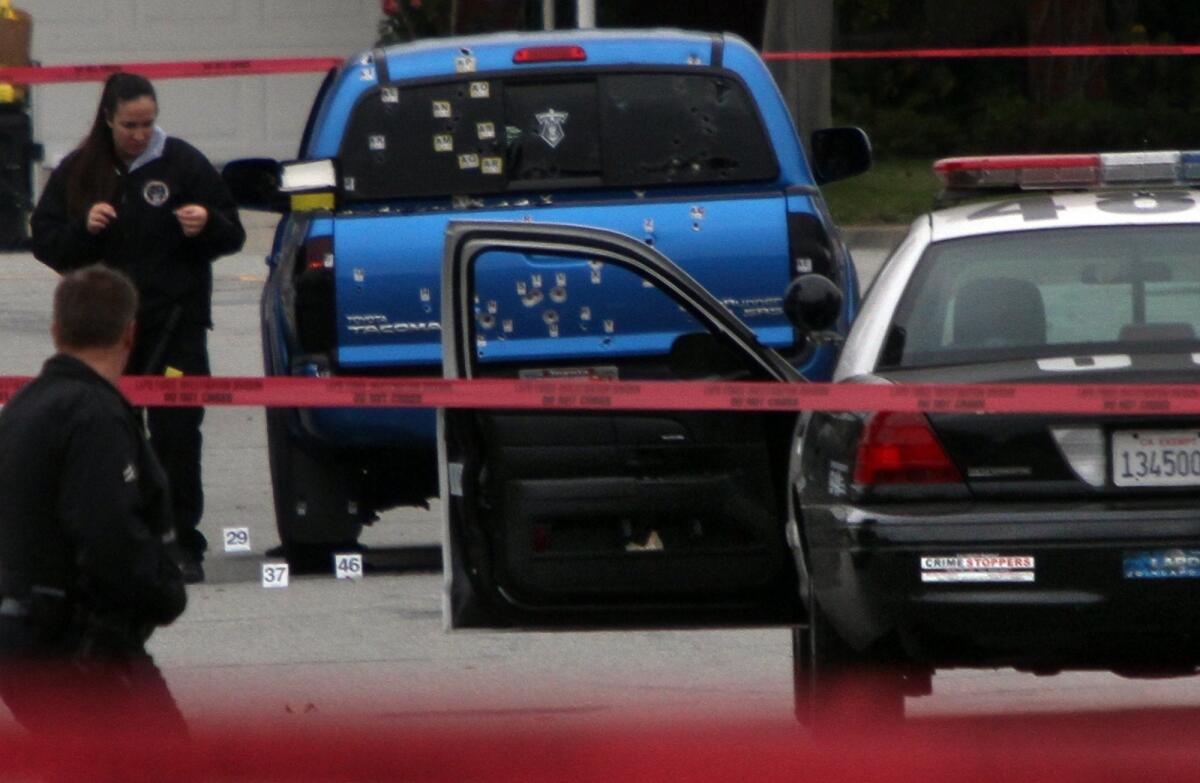Police Commission: Cops violated policy in Dorner mistaken-ID shooting

Investigators collect evidence on Feb. 7, 2013, after police officers opened fire on a pickup truck in a case of mistaken identity, wounding two women who were delivering newspapers.
- Share via
The Los Angeles Police Commission on Tuesday unanimously accepted Chief Charlie Beck’s finding that eight officers who opened fire on two women in a pickup truck during a search for Christopher Dorner violated the department’s policy on using deadly force.
The Police Commission, which oversees the LAPD, has the final word on police shootings. Beck will now determine how to discipline the officers, if at all.
In a statement, Police Commission President Steve Soboroff called the shooting “tragic.” He declined to discuss the commission’s closed-door deliberations, citing state law.
MORE: The manhunt for Christopher Dorner
“As in all Use of Force incidents, the Department has completed a thorough review and will adopt the lessons learned, both good and bad,” he said.
The finding comes a year after the massive manhunt for Dorner, the ex-LAPD officer who sought vengeance against law enforcement officials he blamed for his firing. Dorner ultimately killed four people and wounded three others before he died of a self-inflicted gunshot wound during a shootout with police near Big Bear.
The Torrance shooting occurred in the predawn hours of Feb. 7, 2013, as the search for Dorner was underway. Officers from the LAPD’s Hollywood Division were dispatched to a quiet residential neighborhood with orders to guard the home of an LAPD captain who had been involved in the decision to fire Dorner for dishonesty and other misconduct.
At some point, the officers received a report that a pickup truck resembling Dorner’s was seen in the area of the house they were guarding. Shortly after 5 a.m., a truck turned onto the street.
The truck -- which had a license plate beginning in “8D,” like Dorner’s -- drove slowly down the street, then accelerated and crossed the center line, Soboroff said in his statement.
“Ultimately, the officers believed by the erratic manner the vehicle was driving that it was occupied by Dorner,” Soboroff said. “These observations led the officers to discharge their weapons at the vehicle to stop the threat.”
As the vehicle approached the house, officers opened fire, unloading a barrage of bullets into the truck. When the shooting stopped, they realized their mistake. The truck was a different make and model -- a Toyota Tacoma, not a Nissan Titan, Soboroff said. The color wasn’t gray, as Dorner’s was, but blue. And it wasn’t Dorner inside the truck, but a woman and her mother delivering copies of the Los Angeles Times.
Investigators found that the officers fired more than 100 times.
In an interview shortly after the shooting, Beck said Margie Carranza, 47, and her mother, Emma Hernandez, 71, were the victims of “a tragic misinterpretation” by officers working under “incredible tension,” he said.
Just hours before, Dorner had shot three police officers, one fatally. And in an online posting authorities attributed to him, he threatened to kill more police and seemed to take responsibility for the slaying of the daughter of a retired LAPD captain and her fiance.
Hernandez was shot twice in the back; her daughter sustained superficial wounds. The women later agreed to a $4.2-million settlement with the city.
A panel of high-ranking police officials that reviewed the shooting urged Beck to clear the officers of wrongdoing, said multiple sources with knowledge of the case, who spoke on the condition that their names not be used because they were not authorized to speak publicly about the case.
Beck, however, ultimately found the officers’ actions could not be justified, the sources said.
Since the shooting, the officers, whom the department has not identified over concerns for their safety, have been assigned to desk jobs to keep them out of the field, police officials said.
The Police Commission also found Tuesday that the two officers involved in an “intense gun battle” with Dorner in Riverside County acted within department policy. That shooting occurred shortly before 1:30 a.m. Feb. 7, as the officers were en route to a protective detail, Soboroff said.
A resident told the officers he thought he had seen Dorner leaving a gas station, Soboroff said. The officers spotted Dorner’s truck and were following it when the vehicle pulled to the side of the road.
The driver’s door opened and Dorner began firing an assault rifle at the officers, Soboroff said. One of the officers was grazed in the head; the other was “sprayed with shattered glass.”
Dorner fled and soon after ambushed two Riverside police officers, seriously injuring one and killing the other.
More to Read
Sign up for Essential California
The most important California stories and recommendations in your inbox every morning.
You may occasionally receive promotional content from the Los Angeles Times.












